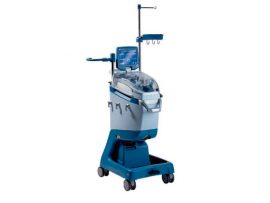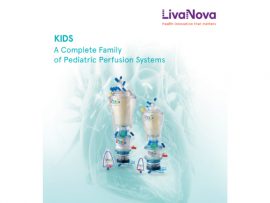Abstract Objectives Patients undergoing cardiac surgery often require , which are associated with increased morbidity and mortality. Patient blood management (PBM) strategies, including acute normovolemic (ANH), have been implemented to minimize allogeneic..
Read MoreAbstract Unfractionated heparin (UFH) is the most used anticoagulant in patients receiving veno-venous extracorporeal membrane oxygenation (VV-ECMO). Its therapeutic levels are monitored using activated partial thromboplastin time ratio (aPTTr) or..
Read MoreAbstract Background The quality of a myocardial protection of a single-dose del Nido cardioplegia versus multiple dose blood-based cardioplegia on myocardial injury, outcomes and operative times in patients undergoing minimally..
Read MoreAbstract Background Concerns regarding the safety and availability of transfused donor blood have prompted research into a range of techniques to minimise allogeneic transfusion requirements. Cell salvage (CS) describes the..
Read MoreAbstract Introduction Extracorporeal membrane oxygenation (ECMO) circuits may be changed during the run for multiple reasons; however, these circuit changes may be associated with adverse events. Predictors for undergoing a..
Read MoreAbstract Biological evidence supports plasma methemoglobin as a biomarker for anemia-induced tissue hypoxia. In this translational planned substudy of the multinational randomized controlled transfusion thresholds in cardiac surgery (TRICS-III) trial,..
Read MoreAbstract Objective To report early outcomes of blood conservation in neonatal open-heart surgery. Methods Ninety-nine patients undergoing neonatal open-heart surgery during the implementation of a blood conservation program between May..
Read MoreAbstract This study described the outcomes of patients receiving topical, nebulized, endobronchial, or systemic tranexamic acid (TXA) for bleeding events while on extracorporeal membrane oxygenation (ECMO). We performed a single-center..
Read MoreAbstract Background Our previous showed that a blood management program in the cardiopulmonary bypass (CPB) department, reduced red blood cell (RBC) transfusion and complications, but assessing transfusion practice solely based..
Read MoreAbstract Targeted oxygen delivery during cardiopulmonary bypass (CPB) has received significant attention due to its influence on patient outcomes, especially in mitigating acute kidney injury. While it has gained popularity..
Read MoreAbstract BACKGROUND: Bleeding is a serious complication of cardiopulmonary bypass (CPB) in neonates. Blood product transfusions are often needed to adequately restore hemostasis, but are associated with significant risks. Thus,..
Read MoreAbstract OBJECTIVES Previous studies indicated higher long-term mortality after the transfusion of allogeneic red blood cells (RBC); newer recommendations emphasize lower transfusion rates. The consequences of the transfusion of RBCs..
Read MoreAbstract Infection is one of the most frequent complications in the management of ECMO patients. Although there are several studies demonstrating the role of ECMO in patients with pre-existing sepsis,..
Read MoreAbstract Objectives A conservative hemoglobin transfusion threshold is noninferior to a liberal threshold in cardiac surgery. However, red blood cell (RBC) transfusion remains common during cardiac surgery. The authors’ single-center,..
Read MoreAbstract BACKGROUND: We examined the relationship between blood transfusion and long-term adverse events to evaluate the clinical impact of red blood cell (RBC) transfusion on patients undergoing cardiac valve surgery...
Read MoreAbstract Purpose Thrombocytopenia (platelet count < 150 × 109/L) is common in intensive care unit (ICU) patients and is likely associated with worse outcomes. In this study we present international contemporary data on thrombocytopenia..
Read MoreAbstract Background: Infants < 10 kg undergoing cardiac surgery with cardiopulmonary bypass (CPB) may receive either fresh frozen plasma (FFP) or other solutions in the CPB priming volume. The existing..
Read MoreAbstract The objective of this study was to investigate the efficacy of intraoperative Cell Saver blood salvage during emergency surgery for massive hemothorax on minimizing perioperative allogeneic red blood cell..
Read MoreAbstract Introduction: The aim of this study was to determine the effect of fresh frozen plasma (FFP) for priming of cardiopulmonary bypass (CPB) circuit on rotational thromboelastometry (ROTEM) and transfusion in..
Read MoreAbstract Purpose Blood transfusion; is considered an organ transplant. In coronary bypass surgery, large volumes of homologous blood transfusion may be required due to excessive bleeding. The large number of..
Read MoreAbstract Background The use of crystalloid priming for extracorporeal circuit in adult cardiac surgery causes inevitable haemodilution. The haemodilution can be reduced by using methods such as retrograde autologous priming..
Read MoreAbstract Background Centrifugation-based autotransfusion devices only salvage red blood cells while platelets are removed. The same™ device (Smart Autotransfusion for ME; i-SEP, France) is an innovative filtration-based autotransfusion device able..
Read MoreAbstract Background Cardiopulmonary bypass (CPB) causes coagulation disorders after surgery. This study aimed to compare the coagulation parameters after congenital cardiac surgery with miniaturised CPB (MCPB) versus conventional CPB (CCPB)...
Read MoreAbstract Introduction Perioperative coagulopathy is common in patients undergoing aortic surgery, increasing the risk of excessive blood loss and subsequent allogeneic transfusion. Blood conservation has become a vital part of cardiovascular..
Read MoreAbstract Background Pediatric cardiac surgery is associated with abnormal coagulation, bleeding, and nearly ubiquitous transfusions. With the popularization of patient blood management, attempts are being made to decrease liberal transfusions..
Read MoreAbstract Background: Congenital heart surgeries are associated with post-bypass renal and cardiac dysfunctions. The use of low-dose vasopressin has been found to be beneficial in adult cardiac surgeries. Objective: To..
Read MoreAbstract Study Design. A retrospective, propensity-matched observational study. Objective. To assess the impact of cell saver (CS) homologous transfusion on perioperative medical complications in adult patients undergoing spinal deformity surgery...
Read MoreAbstract Objectives Perioperative transfusion thresholds have garnered increasing scrutiny as restrictive strategies have been shown to be noninferior. The study authors used data from a statewide academic collaborative to test..
Read MoreAbstract Background A multidisciplinary Quality Assurance/Performance Improvement study to identify the incidence of “heparin rebound” in our adult cardiac surgical population instead detected a thromboelastometry pattern suggestive of initial protamine..
Read MoreAbstract Background: Patient blood management (PBM) is a multidisciplinary and patient-centered treatment approach, comprising the detection and treatment of anemia, the minimization of blood loss, and the rational use of allogeneic..
Read More








